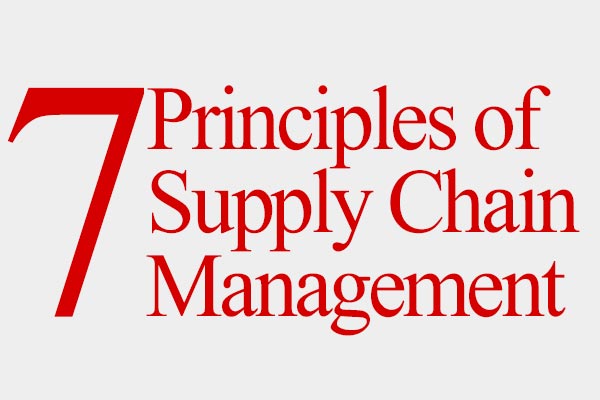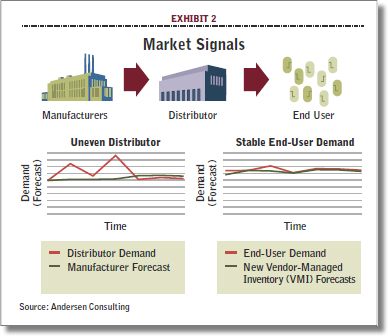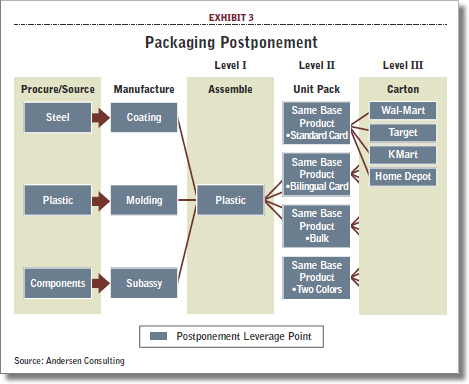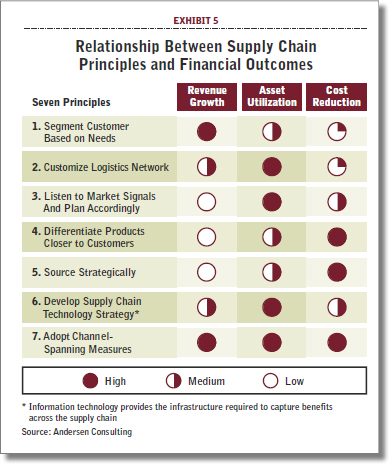The Seven Principles of Supply Chain Management
Managers increasingly find themselves assigned the role of the rope in a very real tug of war - pulled one way by customers’ mounting demands and the opposite way by the company’s need for growth and profitability.
Many have discovered that they can keep the rope from snapping and, in fact, achieve profitable growth by treating supply chain management as a strategic variable.
These savvy managers recognize two important things.
First, they think about the supply chain as a whole - all the links involved in managing the flow of products, services, and information from their suppliers’ suppliers to their customers’ customers (that is, channel customers, such as distributors).
Second, they pursue tangible outcomes - focused on revenue growth, asset utilization, and cost.
Rejecting the traditional view of a company and its component parts as distinct functional entities, these managers realize that the real measure of success is how well activities coordinate across the supply chain to create value for customers while increasing the portability of every link in the chain.
Our analysis of initiatives to improve supply chain management by more than 100 manufacturers, distributors, and retailers shows case many making great progress, while others fail dismally. The successful initiatives that have contributed to profitable growth-share several themes. They are typically broad efforts, combining both strategic and tactical change.
They also reflect a holistic approach, viewing the supply chain from end to end and orchestrating efforts so that the whole improvement achieved - in revenue, costs, and asset utilization - is greater than the sum of its parts.
Unsuccessful efforts likewise have a consistent profile. They tend to be functionally defined and narrowly focused, and they lack sustaining infrastructure. Uncoordinated change activity erupts in every department and function and puts the company in grave danger of “dying the death of a thousand initiatives.”
The source of failure is seldom management’s difficulty identifying what needs fixing. The issue is determining how to develop and execute a supply chain transformation plan that can move multiple, complex operating entities (both internal and external) in the same direction.
To help managers decide how to proceed, we revisited the supply chain initiatives undertaken by the most successful manufacturers and distilled from their experience seven fundamental principles of supply chain management.
Principle 1: Segment customers based on the service needs of distinct groups and adapt the supply chain to serve these segments profitably
Segmentation has traditionally grouped customers by industry, product, or trade channel and then taken a one-size-fits-all approach to serving them, averaging costs and profitability within and across segments. The typical result, as one manager admits: “We don’t fully understand the relative value customers place on our service offerings.”
But segmenting customers by their particular needs equips a company to develop a portfolio of services tailored to various segments. Surveys, interviews, and industry research have been the traditional tools for defining key segmentation criteria.
Viewed from the classic perspective, this needs-based segmentation may produce some odd couples. For the manufacturer in Exhibit 1, “innovators” include an industrial distributor (Grainger), a do-it-yourself retailer (Home Depot), and a mass merchant (Wal-Mart).
Research also can establish the services valued by all customers versus those valued only by certain segments. Then the company should apply a disciplined, cross-functional process to develop a menu of supply chain programs and create segment-specific service packages that combine basic services for everyone with the services from the menu that will have the greatest appeal to particular segments. This does not mean tailoring for the sake of tailoring. The goal is to find the degree of segmentation and variation needed to maximize profitability.
All the segments in Exhibit 1, for example, value consistent delivery. But those in the lower-left quadrant have little interest in the advanced supply chain management programs, such as customized packaging and advance shipment notification, that appeal greatly to those in the upper right quadrant.
Of course, customer needs and preferences do not tell the whole story. The service packages must turn a profit, and many companies lack adequate financial understanding of their customers’ and their own costs to gauge likely profitability.
“We don’t know which customers are most profitable to serve, which will generate the highest long-term profitability, or which we are most likely to retain,” confessed a leading industrial manufacturer. This knowledge is essential to correctly match accounts with service packages - which translates into revenues enhanced through some combination of increases in volume and/or price.
Only by understanding their costs at the activity level and using that understanding to strengthen fiscal control can companies profitably deliver value to customers. One “successful” food manufacturer aggressively marketed vendor-managed inventory to all customer segments and boosted sales. But subsequent activity-based cost analysis found that one segment actually lost nine cents a case on an operating margin basis.
Most companies have a significant untapped opportunity to better align their investment in a particular customer relationship with the return that the customer generates. To do so, companies must analyze the profitability of segments, plus the costs and benefits of alternate service packages, to ensure a reasonable return on their investment and the most profitable allocation of resources.
To strike and sustain the appropriate balance between service and profitability, most companies will need to set priorities - sequencing the rollout of tailored programs to capitalize on existing capabilities and maximize customer impact.
Principle 2: Customize the logistics network to the service requirements and profitability of customer segments
Companies have traditionally taken a monolithic approach to logistics network design in organizing their inventory, warehouse, and transportation activities to meet a single standard. For some, the logistics network has been designed to meet the average service requirements of all customers; for others, to satisfy the toughest requirements of a single customer segment.
Neither approach can achieve superior asset utilization or accommodate the segment-specific logistics necessary for excellence in supply chain management. In many industries, especially such commodity industries as fine paper, tailoring distribution assets to meet individual logistics requirements is a greater source of differentiation for a manufacturer than the actual products, which are largely undifferentiated.
One paper company found radically different customer service demands in two key segments - large publishers with long lead times and small regional printers needing delivery within 24 hours. To serve both segments well and achieve profitable growth, the manufacturer designed a multi-level logistics network with three full-stocking distribution centers and 46 quick-response cross-docks, stocking only fast-moving items, located near the regional printers.
Return on assets and revenues improved substantially thanks to the new inventory deployment strategy, supported by the outsourcing of the management of the quick response centers and the transportation activities.
This example highlights several key characteristics of segment-specific services. The logistics network probably will be more complex, involving alliances with third-party logistics providers, and will certainly have to be more flexible than the traditional network. As a result, fundamental changes in the mission, number, location, and ownership structure of warehouses are typically necessary.
Finally, the network will require more robust logistics planning enabled by “real-time” decision-support tools that can handle flow-through distribution and more time-sensitive approaches to managing transportation.
Principle 3: Listen to market signals and align demand planning accordingly across the supply chain, ensuring consistent forecasts and optimal resource allocation
Forecasting has historically proceeded silo by silo, with multiple departments independently creating forecasts for the same products - all using their own assumptions, measures, and level of detail.
Many consult the marketplace only informally, and few involve their major suppliers in the process. The functional orientation of many companies has just made things worse, allowing sales forecasts to envision growing demand while manufacturing second-guesses how much product the market actually wants.
Such independent, self-centered forecasting is incompatible with excellent supply chain management, as one manufacturer of photographic imaging found. This manufacturer nicknamed the warehouse “the accordion” because it had to cope with a production operation that stuck to a stable schedule, while the revenue-focused salesforce routinely triggered cyclical demand by offering deep discounts at the end of each quarter. The manufacturer realized the need to implement a cross-functional planning process, supported by demand planning software.
The initial results were dismaying. Sales volume dropped sharply, as excess inventory had to be consumed by the marketplace. But today, the company enjoys lower inventory and warehousing costs and a much greater ability to maintain price levels and limit discounting. Like all the best sales and operations planning (S&OP), this process recognizes the needs and objectives of each functional group but bases final operational decisions on overall profit potential.
Excellent supply chain management, in fact, calls for S&OP that transcends company boundaries to involve every link of the supply chain (from the supplier’s supplier to the customer’s customer) in developing forecasts collaboratively and then maintaining the required capacity across the operations.
Channel-wide S&OP can detect early warning signals of demand lurking in customer promotions, ordering patterns, and restocking algorithms and takes into account vendor and carrier capabilities, capacity, and constraints.
Exhibit 2 illustrates the difference that cross supply chain planning has made for one manufacturer of laboratory products. As shown on the left of this exhibit, uneven distributor demand unsynchronized with actual end-user demand made real inventory needs impossible to predict and forced high inventory levels that still failed to prevent out-of-stocks.
Distributors began sharing information on actual (and fairly stable) end-user demand with the manufacturer, and the manufacturer began managing inventory for the distributors. This coordination of manufacturing scheduling and inventory deployment decisions paid off handsomely, improving fill rates, asset turns, and cost metrics for all concerned.
Principle 4: Differentiate product closer to the customer and speed conversion across the supply chain
Manufacturers have traditionally based production goals on projections of the demand for finished goods and have stockpiled inventory to offset forecasting errors. These manufacturers tend to view lead times in the system as fixed, with only a finite window of time in which to convert materials into products that meet customer requirements.
While even such traditionalists can make progress in cutting costs through set-up reduction, cellular manufacturing, and just-in-time techniques, the great potential remains in less traditional strategies such as mass customization. For example, manufacturers striving to meet individual customer needs efficiently through strategies such as mass customization are discovering the value of postponement.
They are delaying product differentiation to the last possible moment and thus overcoming the problem described by one manager of a health and beauty care products warehouse: “With the proliferation of packaging requirements from major retailers, our number of SKUs (stock-keeping units) has exploded. We have situations daily where we backorder one retailer, like Wal-Mart, on an item that is identical to an in-stock item, except for its packaging. Sometimes we even tear boxes apart and repackage by hand!”
The hardware manufacturer in Exhibit 3 solved this problem by determining the point at which a standard bracket turned into multiple SKUs. This point came when the bracket had to be packaged 16 ways to meet particular customer requirements. The manufacturer further concluded that the overall demand for these brackets is relatively stable and easy to forecast, while demand for the 16 SKUs is much more volatile.
The solution: make brackets in the factory but package them at the distribution center, within the customer order cycle. This strategy improved asset utilization by cutting inventory levels by more than 50 percent.
Realizing that time really is money, many manufacturers are questioning the conventional wisdom that lead times in the supply chain are fixed. They are strengthening their ability to react to market signals by compressing lead times along the supply chain, speeding the conversion from raw materials to finished products tailored to customer requirements.
This approach enhances their flexibility to make product configuration decisions much closer to the moment demand occurs.
The key to just-in-time product differentiation is to locate the leverage point in the manufacturing process where the product is unalterably configured to meet a single requirement and to assess options, such a postponement, modularized design, or modification of manufacturing processes, that can increase flexibility. In addition, manufacturers must challenge cycle times: Can the leverage point be pushed closer to actual demand to maximize the manufacturer’s flexibility in responding to emerging customer demand?
Principle 5: Manage sources of supply strategically to reduce the total cost of owning materials and services
Determined to pay as low a price as possible for materials, manufacturers have not traditionally cultivated warm relationships with suppliers. In the words of one general manager: “The best approach to supply is to have as many players as possible fighting for their piece of the pie - that’s when you get the best pricing.”
Excellent supply chain management requires a more enlightened mindset - recognizing, as a more progressive manufacturer did: “Our supplier’s costs are in effect our costs. If we force our supplier to provide 90 days of consigned material when 30 days are sufficient, the cost of that inventory will find its way back into the supplier’s price to us since it increases his cost structure.”
While manufacturers should place high demands on suppliers, they should also realize that partners must share the goal of reducing costs across the supply chain in order to lower prices in the marketplace and enhance margins. The logical extension of this thinking is gain-sharing arrangements to reward everyone who contributes to greater profitability.
Some companies are not yet ready for such progressive thinking because they lack fundamental prerequisites. That is a sound knowledge of all their commodity costs, not only for direct materials but also for maintenance, repair, and operating supplies, plus the dollars spent on utilities, travel, temps, and virtually everything else.
This fact-based knowledge is the essential foundation for determining the best way of acquiring every kind of material and service the company buys.
With their marketplace position and industry structure in mind, manufacturers can then consider how to approach suppliers - soliciting short-term competitive bids, entering into long-term contracts and strategic supplier relationships, outsourcing, or integrating vertically. Excellent supply chain management calls for creativity and flexibility.
Principle 6: Develop a supply chain-wide technology strategy that supports multiple levels of decision making and gives a clear view of the flow of products, services, and information
To sustain re-engineered business processes (that, at last, abandon the functional orientation of the past), many progressive companies have been replacing inflexible, poorly integrated systems with enterprise-wide systems. Yet too many of these companies will find themselves victims of the powerful new transactional systems they put in place.
Unfortunately, many leading-edge information systems can capture reams of data but cannot easily translate it into actionable intelligence that can enhance real-world operations. As one logistics manager with a brand-new system said: “I’ve got three feet of reports with every detail imaginable, but it doesn’t tell me how to run my business.”
This manager needs to build an information technology system that integrates capabilities of three essential kinds. (See Exhibit 4.) In the short term, the system must be able to handle day-to-day transactions and electronic commerce across the supply chain and thus help align supply and demand by sharing information on orders and daily scheduling.
From a mid-term perspective, the system must facilitate planning and decision making, supporting the demand and shipment planning, and master production scheduling needed to allocate resources efficiently.
To add long-term value, the system must enable strategic analysis by providing tools, such as an integrated network model, that synthesize data for use in high-level “what-if” scenario planning to help managers evaluate plants, distribution centers, suppliers, and third-party service alternatives.
Despite making huge investments in technology, few companies are acquiring this full complement of capabilities. Today’s enterprise-wide systems remain enterprise-bound, unable to share across the supply chain the information that channel partners must have to achieve mutual success.
Ironically, the information that most companies require most urgently to enhance supply chain management resides outside of their own systems, and few companies are adequately connected to obtain the necessary information.
Electronic connectivity creates opportunities to change the supply chain fundamentally - from slashing transaction costs through electronic handling of orders, invoices, and payments to shrinking inventories through vendor-managed inventory programs.
Principle 7: Adopt channel-spanning performance measures to gauge collective success in reaching the end-user effectively and efficiently
To answer the question, “How are we doing?” most companies look inward and apply any number of functionally oriented measures. But excellent supply chain managers take a broader view, adopting measures that apply to every link in the supply chain and include both service and financial metrics.
First, they measure service in terms of the perfect order - the order that arrives when promised, complete, priced, and billed correctly, and undamaged. The perfect order not only spans the supply chain, as a progressive performance measurement should but also view the performance from the proper perspective, that of the customer.
Second, excellent supply chain managers determine their true profitability of service by identifying the actual costs and revenues of the activities required to serve an account, especially a key account. For many, this amounts to a revelation, since traditional cost measures rely on corporate accounting systems that allocate overhead evenly across accounts.
Such measures do not differentiate, for example, an account that requires a multi-functional account team, small daily shipments, or special packaging. Traditional accounting tends to mask the real costs of the supply chain - focusing on cost-type rather than the cost of activities and ignoring the degree of control anyone has (or lacks) over the cost drivers.
Deriving maximum bene.t from activity-based costing requires sophisticated information technology, specifically a data warehouse. Because the general ledger organizes data according to a chart of accounts, it obscures the information needed for activity-based costing. By maintaining data in discrete units, the warehouse provides ready access to this information.
To facilitate channel-spanning performance measurement, many companies are developing common report cards. These report cards help keep partners working toward the same goals by building a deep understanding of what each company brings to the partnership and showing how to leverage their complementary assets and skills to the alliance’s greatest advantage.
The willingness to ignore traditional company boundaries in pursuit of such synergies often marks the first step toward a “pay-for-performance” environment.
Translating Principles into Practice
Companies that have achieved excellence in supply chain management tend to approach the implementation of the guiding principles with three precepts in mind:
Orchestrate Improvement Efforts
The complexity of the supply chain can make it difficult to envision the whole, from end to end. But successful supply chain managers realize the need to invest time and effort upfront in developing this total perspective and using it to inform a blueprint for change that maps linkages among initiatives and a well-thought-out implementation sequence.
This blueprint also must coordinate the change initiatives with ongoing day-to-day operations and must cross company boundaries.
The blueprint requires rigorous assessment of the entire supply chain - from supplier relationships to internal operations to the marketplace, including customers, competitors, and the industry as a whole. Current practices must be ruthlessly weighed against best practices to determine the size of the gap to close.
Thorough cost/benefit analysis lays the essential foundation for prioritizing and sequencing initiatives, establishing capital and people requirements, and getting a complete financial picture of the company’s supply chain - before, during, and after implementation.
A critical step in the process is setting explicit outcome targets for revenue growth, asset utilization, and cost reduction. (See Exhibit 5.)
While traditional goals for costs and assets, especially goals for working capital, remain essential to success, revenue growth targets may ultimately be even more important.
Initiatives intended only to cut costs and improve asset utilization have limited success in structuring sustainable win-win relationships among trading partners.
Emphasizing revenue growth can significantly increase the odds that a supply chain strategy will create, rather than destroy, value.
Remember that Rome Wasn’t Built in a Day
As this list of tasks may suggest, significant enhancement of supply chain management is a massive undertaking with a profound financial impact on both the balance sheet and the income statement.
Because this effort will not pay off overnight, management must carefully balance its long-term promise against more immediate business needs.
Advance planning is again key. Before designing specific initiatives, successful companies typically develop a plan that specifies funding, leadership, and expected financial results. This plan helps to forestall conflicts over priorities and keeps management focused and committed to realizing the benefits.
Recognize the Difficulty of Change
Most corporate change programs do a much better job of designing new operating processes and technology tools than of fostering appropriate attitudes and behaviors in the people who are essential to making the change program work.
People resist change, especially in companies with a history of “change-ofthe-month” programs. People in any organization have trouble coping with the uncertainty of change, especially the real possibility that their skills will not fit the new environment.
Implementing the seven principles of supply chain management will mean a significant change for most companies. The best prescription for ensuring success and minimizing resistance is extensive, visible participation and communication by senior executives.
This means championing the cause and removing the managerial obstacles that typically present the greatest barriers to success while linking change with overall business strategy.
Many progressive companies have realized that the traditionally fragmented responsibility for managing supply chain activities will no longer do. Some have even elevated supply chain management to a strategic position and established a senior executive position such as vice president-supply chain (or the equivalent) reporting directly to the COO or CEO.
This role ignores traditional product, functional, and geographic boundaries that can interfere with delivering to customers what they want, when, and where they want it.
Reaping the Rewards
The companies mentioned in this article are just a few of the many that have enhanced both customer satisfaction and profitability by strengthening the management of the supply chain.
While these companies have pursued various initiatives, all have realized the need to integrate activities across the supply chain. Doing so has improved asset utilization, reduced cost, and created price advantages that help attract and retain customers - and thus enhance revenue.
Note: When this article was first published, David L. Anderson and Donavon J. Favre were consultants in Andersen Consulting’s Strategic Services Logistics Practice. Frank F. Britt, an alumnus of that practice, was Vice President of Marketing and Merchandising at Streamline Inc.
About the Author
Follow Robotics 24/7 on Linkedin
Article topics
Email Sign Up





















